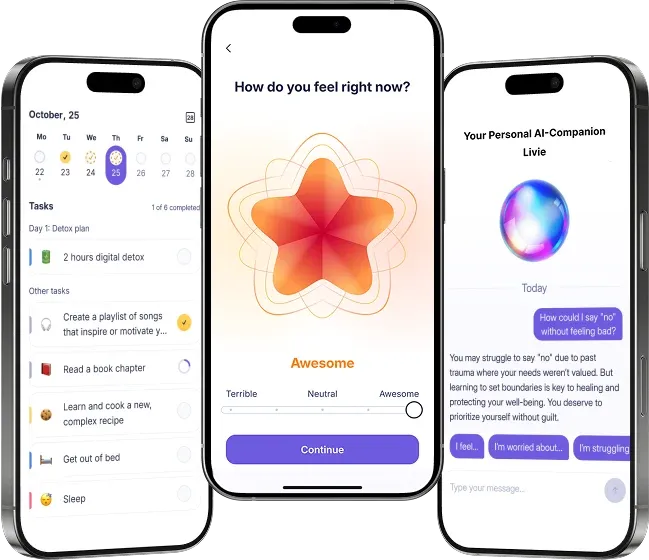Empowering Decision-Making Beyond Overthinking

When thoughts spiral out of control, overwhelming a person with numerous possible scenarios, the risk of analysis paralysis increases. This phenomenon can occur in various situations, from mundane tasks to significant life decisions. The constant flow of options and potential outcomes can create a deadlock, where the fear of making an incorrect choice obstructs making good decisions. This blockage can lead to anxiety, fatigue, and other serious issues, perpetuating creative constraints and starting a cycle of inaction.
How Overthinking and Analysis Paralysis Affect the Brain
Overthinking entails various effects on the brain, understanding which specifics are critical for developing practical, individually tailored recovery approaches that mitigate these challenges and help shift focus away from the negative. Although not classified as a mental state, persistent thought patterns are closely linked to depression and anxiety, serving as one of their most apparent manifestations.
Cognitive Overload and Stress
As a frequent outcome of overthinking, cognitive overload occurs when the brain is overwhelmed by a whirlpool of excessive thoughts, hindering working memory, attentiveness, and the ability to make choices. This, in turn, leads to diminished productivity and becomes a significant source of stress.
Due to the increased release of cortisol and other hormones associated with heightened anxiety levels, overthinking creates a sustained troubling rumination cycle that impairs the ability to process large volumes of information. It results in persistent low spirits, along with headaches, fatigue, and insomnia as widespread physical manifestations. These symptoms further aggravate stress, perpetuating this ongoing pattern and making it urgent to break.
Second-Guessing and Doubt
Rethinking the same cases leads to creating one scenario after another, complicating the ability to manage these feelings due to increased activity in the brain's Default Mode Network (DMN). This activation is linked to lower coping flexibility — the capacity to adaptively shift between healing strategies in response to stressors — suggesting a rise in worry and rumination.
However, engaging in mental stimulation can promote effective meaning-making, which reduces DMN activity by facilitating the integration of interconnected brain areas during information processing, ultimately improving our ability to cope with stressful challenges. People often sow doubts about their decisions due to a fear of commitment and making an unsuitable choice, a mindset reinforced by rigid distinctions between "right" and "incorrect" options. Incessant rumination can intensify feelings of shame, guilt, and worry that might leave a distorted view of reality.
The Poor Outcome of Overthinking Decisions
Nowadays, the problem-solving process has become decidedly more complicated due to the rapidly generated range of variations, leading individuals to take the path of least resistance, often yielding suboptimal results. Making a decision can be stressful because of cognitive constraints like overwhelming information, memory limitations, and the "tunnel vision" effect, further compounded by the fear of failure and judgment, which can intensify under pressure.
These factors strain executive functioning by obstructing the remembering of diverse information, impairing focus on relevant tasks, and limiting the control of impulses and decision-making — all of which ultimately challenge the brain's processing of complex, abstract concepts. Understanding the consequences of overthinking is essential for guiding individuals in choosing the appropriate recovery approach.
Missed Opportunities
The feeling of regret from overthinking often arises from a sense of lost opportunity — when people dwell on things they could have changed in the past but can no longer alter, which are among the most commonly regretted experiences — especially when there is a lack of closure. Overthinking can manifest as rumination, overanalyzing, and future tripping — the tendency to imagine worst-case scenarios — all leading to heightened anxiety and other stressful sensations.
Decision fatigue and poor time management fuel a cycle of missed chances and stagnation, while paralysis by analysis traps individuals in a state of reconsidering every possible scenario, preventing them from making any decisions. Consequently, when opportunities arise, the path to implementation becomes paralyzing due to the fear of making the wrong choice. Although reflecting on challenging situations sometimes stimulates deeper self-awareness and coping mechanisms, it can exacerbate anxiety and depression, draining motivation and energy while fostering a detrimental loop that obstructs self-development and professional growth.
Indecision and Regret
Strongly tied to the phenomenon of overthinking, indecision and regret can significantly impact an individual's psychological health and problem-solving processes. Among the primary catalysts of indecision is the fear of regret, which manifests as ongoing anxiety about future choices and shifts the perception of worrying from a possibility to a probability. People often experience the most intense regret over outcomes that cannot be repeated, especially when they believe their current opportunities are fewer than those they had in the past.
This observation of fleeting future opportunities is closely tied to the need to resolve cognitive dissonance and seek closure. When confronted with multiple equally appealing or unappealing options, individuals may experience ambivalence, which can lead to greater indecision. It can result from a deep-seated belief in the superiority of one choice over another, creating a "grass is greener" mentality marked by remorse for the decisions made.
Chronic indecision and regret can negatively influence overall life satisfaction, primarily stemming from the difficulty in appreciating present circumstances due to persistent second-guessing and anxiety over previous choices. Anxiety and chronic stress can disrupt the prefrontal cortex — the region responsible for rational, conscious thought and making decisions — leading to poor choices and heightened feelings of regret and dissatisfaction later on, which means more stress for the person.
Strategies to Break the Cycle
The urgency to break the cycle of overthinking and analysis paralysis is influenced by multiple factors, primarily related to mental health, which declines due to the ongoing presence of worry and depression associated with constant rumination and the relentless reevaluation of scenarios focused on finding a single decision. Along with tackling anxiety as one of the roots of overthinking, eliminating this bad habit can alleviate stress and improve well-being while also mitigating tension, sleep disturbances, poor performance of the working memory, and the physical and mental fatigue that come with them.
Although various challenges may complicate the journey to overcome overthinking decisions and analysis paralysis, there are many multifaceted strategies for effectively managing these issues and moving forward. Among them are mindfulness practices focused on grounding an individual in the present moment, while setting clear goals can simplify the process of making big decisions as well as the small ones.
Setting Time Limits for Decision-Making Process
Setting time constraints for selecting options has proven effective in combating overthinking for several reasons. A clear deadline creates a sense of urgency, alleviating the anxiety accompanying extended pondering. With the pressure of a ticking clock, individuals tend to focus more on the core elements of their decisions instead of getting bogged down in trivial matters. Shifting from the more complex approaches, such as analytical reasoning and framing effects, to making good decisions promotes quicker, more instinctive decisions in the face of tighter time frames for deliberation.
While setting deadlines can promote heuristics — mental shortcuts that eliminate decision paralysis — such limitations, people engage in haphazard rather than focused exploration, often guided by instant assessments when selecting alternatives without considering each option in the long term. In addition, this strategy effectively regulates emotional responses by preventing analysis paralysis and the fear of making the wrong decision from overwhelming you, thus promoting a more direct acceptance of ambiguity and the intrinsic risks involved.
One practical application of time-framed approaches is incorporating timers into your daily routine as physical reminders to keep limiting making decisions to some extent. This is particularly useful for managing less critical tasks that may interfere with focusing on primary goals. Need to choose a café for lunch? Ten minutes should be enough. Reducing the number of choices will also alleviate the overwhelming pressure of having too many alternatives.
Focusing on Priorities
Honing in on priorities is another effective way to combat overthinking, as it directs individuals toward what truly matters and thus reduces the cognitive load associated with excessive rumination. Streamlining the process of making choices through prioritization minimizes the risk of catching up in minor matters, frequently fueling prolonged deliberation. By creating a sense of urgency, this strategy encourages you to take action, while a structured environment limits the time available for unnecessary contemplation.
It also involves letting go of perfectionism, replacing the quest for "perfect" choices with an awareness of the nuances inherent in each decision. It contributes to desensitization, diminishing the need for endless weighing of options driven by the fear of making the wrong choice. By acknowledging that perfection is out of reach, individuals can alleviate the pressure they place on themselves to make unblemished decisions.
One practical approach to prioritization is the 10/10/10 technique, developed by Suzy Welch. The method involves gaining perspective on decisions by evaluating possible scenarios over 10 minutes, 10 months, and 10 years (the short-term, mid-term, and long-term impacts). This perspective helps slow the influx of thoughts and reduces the tendency to overthink.
Using a Structured Decisional Process
A structured approach is one of the most valuable decision-making process hacks for combating overthinking. Its principle involves filtering out unnecessary information, which reduces the cognitive overload that can lead to anxiety and often triggers analysis paralysis. It also clarifies priorities before delving into the details, streamlining the process of finding a solution and minimizing the tendency to become stuck on each available option.
By incorporating specific criteria for analyzing outcomes, this approach allows you to focus on the advantages and disadvantages of each potential outcome without being hindered by subjective fears and doubts, leading to more thoughtful decisions. Additionally, by providing space for reflection on previous choices, the iterative process of considering multiple perspectives cultivates a growth mindset, enabling rapid adaptation and self-education.
Making Pros and Cons List
The well-known plus-minus list technique is a powerful, structured method for making decisions, especially when confronted with confusing alternatives. Systematic evaluation, along with visualization of potential positive aspects and drawbacks, lays the groundwork for making informed decisions by clarifying thoughts and effectively organizing the insights. Simultaneous consideration of both positive and negative characteristics promotes a more objective analysis by reducing cognitive distortions that can cloud judgment and lead individuals to make biased or erroneous decisions.
Implementing a Decision Matrix
Creating a decision matrix — a structured tool for evaluating multiple options and selecting the best one — is especially beneficial for complex decisions, as it provides a systematic framework for reviewing various alternatives and competing factors. Arranged in a table format, with options on one axis and evaluation criteria on the other, this quantitative method allows a straightforward comparison of how effectively each potential choice meets the established criteria.
Given the varying importance of different criteria, a decision matrix helps in assessing each one, ensuring that the most significant factors have a greater influence when arriving at the final choice. Through scoring each option based on its compliance with the criteria, it minimizes the influence of personal beliefs and promotes a more objective assessment.
This approach can also serve as a catalyst for meaningful discussions among stakeholders, helping to achieve consensus. However, while the matrix provides a structured tool for decision-making, the effectiveness and objectivity of the outcomes still depend on the criteria and weighting factors set by the individual.
Trusting Your Intuition
As paradoxical as it may sound, it can be better to trust your intuition in some situations, especially in structured contexts where swift determinations are essential. Informed intuition, arising from extensive experience in a particular area, enhances the ability to recognize patterns and supports problem-solving through unconscious thinking. It is particularly impactful in familiar occasions where a repertoire of responses has been shaped.
When to Seek External Input
Finding a middle ground when deciding whether to seek help or opinions from others is essential versus remaining self-reliant in your choices. While seeking external input can provide valuable insights, it may also lead to dependence on others' views, potentially compromising your ability to make autonomous selections. However, seeking external assistance can offer clarity and illuminate different perspectives when confronted with significant decisions involving multiple alternatives and stakeholders.
Ask for advice without relying on others too much. Seeking external input should be preceded by self-reflection on the issue, paying special attention to analyzing your feelings to understand what type of feedback you desire. It is valuable to set boundaries on the frequency of seeking advice to ensure that your decision-making skills do not become stagnant.
Encouraging diverse perspectives is key to success. Building an inclusive environment that gives everyone a voice allows you to gather different viewpoints from stakeholders who feel comfortable in the atmosphere you've created. Make the regular solicitation of diverse opinions an integral part of your processes by normalizing the exchange of information. Additionally, allowing for anonymous feedback can encourage honest, constructive criticism that may not otherwise be expressed publicly, fostering a culture of openness and continuous improvement.
Empowering yourself to make confident decisions is a transformative journey that demands self-awareness, proactive engagement, and a commitment to personal growth. Embracing your strengths, setting clear goals, and seeking diverse perspectives can cultivate the confidence needed to navigate life's challenges effectively. Finding the root cause of your analysis paralysis boosts the improvement process and sets your mind free to make big decisions and taking confident steps towards peace.
References
Wu, C. M., Schulz, E., Pleskac, T. J., & Speekenbrink, M. (2022). Time pressure changes how people explore and respond to uncertainty. Scientific Reports, 12, 4122. https://doi.org/10.1038/s41598-022-07901-1
Zhang, W., Hashemi, M. M., Kaldewaij, R., Koch, S. B. J., Beckmann, C., Klumpers, F., & Roelofs, K. (2019). Acute stress alters the ‘default’ brain processing. NeuroImage, 189, 870-877. https://doi.org/10.1016/j.neuroimage.2019.01.063
Beike, D., Markman, K. D., & Karadogan, F. (2009). What we regret most are lost opportunities: A theory of regret intensity. Personality and Social Psychology Bulletin, 35(3), 385-397. https://doi.org/10.1177/0146167208328329
Sandi, C. (2013). Stress and cognition. Wiley Interdisciplinary Reviews: Cognitive Science, 4(3), 245-261. https://doi.org/10.1002/wcs.1222
Elwyn, G., Price, A., Franco, J. V. A., & Gulbrandsen, P. (2022). The limits of shared decision making. BMJ Evidence-Based Medicine, 28(4), 218–221. https://doi.org/10.1136/bmjebm-2022-112089
Kaiser, B. N., Haroz, E. E., Kohrt, B. A., Bolton, P. A., Bass, J. K., & Hinton, D. E. (2015). “Thinking too much”: A systematic review of a common idiom of distress. Social Science & Medicine, 147, 170–183. https://doi.org/10.1016/j.socscimed.2015.10.044

